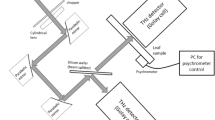Summary
A new method of in vivo pH determination in the xylem of broad-leaved trees using ion-sensitive field effect transistors is developed and its suitability for use is studied. In the first few hours after the sensor had been implanted in the xylem signals could be detected which were generated in response to mechanical damage; particularly strong signal changes are detectable in Populus balsamifera L., Tilia cordata Mill, and Aesculus hippocastanum L. The pH values of the xylem sap extracted from branches corresponded to the values measured by the in vivo method only at certain times. Due to sensor drift the measuring accuracy of long-term experiments lasting up to 3 weeks is restricted. The in vivo measurement of pH in the xylem of poplar branches revealed the ability of the living xylem to buffer the pH of the sap to its own characteristic value.
Similar content being viewed by others
References
Bennett JP, Andersen FG, Milad Y (1927) Methods of obtaining tracheal sap from woody plants. New Phytol 26: 316–323
Bergveld P (1981) The operation of an ISFET as an electronic device. Sens Act 1: 17–29
Bollard EG (1953) The use of tracheal sap in the study of apple tree nutrition. J Exp Bot 4: 363–368
Clarkson DT, Williams L, Hanson JB (1984) Perfusion of onion xylem vessels: a method and evidence of control of the pH of the xylem sap. Planta 162: 361–369
Dixon HH, Atkins WRG (1916) Osmotic pressure in plants. VI. The composition of the sap in the conducting tracts of trees at different levels and at different seasons of the year. Sci Proc R Dublin Soc 5: 51–62
Essiamah SK (1982) Frühjahrsaktivitäten bei einheimischen Laubbäumen. Dissertation University Göttingen, FRG
Ferguson AR (1980) Xylem sap from Actinida chinensis: apparent differences in sap composition arising from the method of collection. Ann Bot 46: 791–801
Glavac V (1987) Die Gewinnung des Xylemwassers von lebenden Bäumen und Analyse seiner Mineralstoffgehalte. Angew Bot 61: 453–466
Harame DL, Bousse L, Shott JD, Meindl J (1987) Ion-sensing devices with silicon nitride and borosilicate glass isolators. IEEE Trans on electr Dev ED-34: 1700–1709
Hart H (1965) Morphological and chemical differences between sapwood, discolored sapwood and heartwood in Black Locust and Osage Orange. For Sci 14: 335–338
Herrmann V, Tesche M, Kaiser S (1989) Versuche zur Applikation von Ionensensitiven Feldeffekttransistoren (ISFET) zur in vivo Messung von pH-Werten im Xylem von Bäumen. Wiss Z Tech Univ Dresden 38: 319–323
Huber B (1956) Die Gefäßleitung. In: Ruhland JW (eds) Handbuch der Pflanzenphysiologie vol 3. Springer, Berlin Heidelberg New York, pp 541–582
Matsuo T, Esashi M (1981) Methods of ISFET fabrication. Sens Act 1: 77–96
Rademacher P (1986) Morphologische und physiologische Eigenschaften von Fichten (Picea abies L.), Tannen (Abies alba Mill.), Kiefern (Pinus sylvestris L.) und Buchen (Fagus sylvatica L.) gesunder und erkrankter Waldstandorte. Dissertation University Hamburg, FRG
Sibbald A (1986) Recent advances in field effect chemical microsensors. J Mol Electr 2: 51–83
Stanislawek S (1987) Sugar content of xylem sap and susceptibility of willow to Chondrostersum purpureum. New Zeal J Bot 25: 263–269
Tattar TA, Blanchard RO (1976) Electrophysiological research in plant pathology. Annu Rev Phytophathol 14: 309–325
Tesche M (1989) Distreß und Eustreß bei Gehölzen. 2. Symposium, Ausgewählte Probleme der Gehölzphysiologie, Techn. Univ. Dresden, Sekt. Forstwirtsch. Tharandt, Tagungsbericht 5–12
Wong HS, White MH (1989) A CMOS-Integrated ISFET-Operational amplifier chemical sensor employing differential sensing. IEEE Trans Electr Dev ED-36: 479–487
Zaerr JB (1982) Pressure chamber device to collect xylem sap from forest trees. For Sci 28: 219–222
Author information
Authors and Affiliations
Additional information
Dedicated to Prof. Dr. O. L. Lange to his 65th birthday
Rights and permissions
About this article
Cite this article
Herrmann, V., Tesche, M. In vivo pH measurement in the xylem of broad-leaved trees using ion-sensitive field-effect transistors. Trees 6, 13–18 (1992). https://doi.org/10.1007/BF00224493
Received:
Accepted:
Issue Date:
DOI: https://doi.org/10.1007/BF00224493




